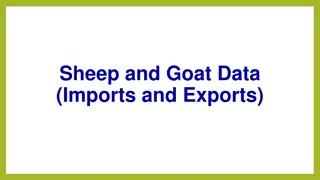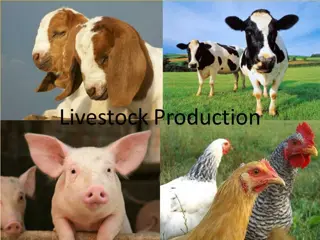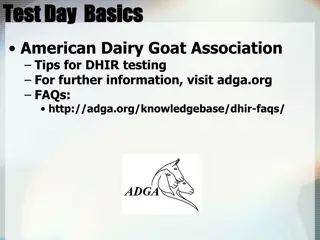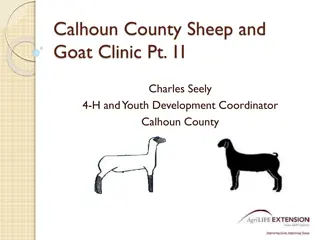Comprehensive Guide to Goat Care and Management
Goat care and management cover a range of aspects including age, health, pregnancy, and environmental needs. Goats are versatile animals used for milk, meat, fiber, and more. Housing options such as confinement and extensive systems play a vital role in goat farming. Understanding these elements ensures the well-being and productivity of goats.
Download Presentation

Please find below an Image/Link to download the presentation.
The content on the website is provided AS IS for your information and personal use only. It may not be sold, licensed, or shared on other websites without obtaining consent from the author.If you encounter any issues during the download, it is possible that the publisher has removed the file from their server.
You are allowed to download the files provided on this website for personal or commercial use, subject to the condition that they are used lawfully. All files are the property of their respective owners.
The content on the website is provided AS IS for your information and personal use only. It may not be sold, licensed, or shared on other websites without obtaining consent from the author.
E N D
Presentation Transcript
Livestock & Poultry Management ASAP2101(2-1-0) Session: 5 Management of sheep, goat and swine
Goat care and management Goat care and management depend on the animal's age, health, pregnancy status, as well as needs, the environment, and facilities. The young kid has needs for basic care very different from the older, mature goat. nutrition production and
Goats are bred and maintained for milk milk products, meat, brush control, mohair, cashmere, skins for leather, commercial antibody production, packing companionship.
Worldwide, there are more 460 million goats producing 4.5 million tons of milk and 1.2 million tons of meat. As browsers, goats utilize land too rough in terrain for sheep and cattle. Goat milk is digested than cow milk.
valued for the elderly, sick, infants, and those with allergic reactions to cow milk. Many goats provide multiple uses, milk for home consumption and offspring for meat, or, in the case of fiber goats, brush control and meat production in addition to mohair or cashmere.
GOAT HOUSING provided with simple shelter protect from rain or snow in winter and from heat in summer. There are two main housing types, which include confinement (intensive) and loose, dry lot or pasture systems (extensive). A combination of housing
The housing should allow groups of milking does, dry(non-lactating) does, newborn kids, growing kids, and bucks to be housed apart from each other.
Confinement housing -a few animals are tethered during the day and put into a protective shelter at night. Extensive-the flock/herd grazes over large areas of marginal land unsuited to agriculture. The flock is usually shut into a yard at night. Intensive- animals are confined to yards and shelters and feed is brought to the flock. offers the greatest protection for the flock from both predators and parasites. also increase labour and the capital investment required for facilities.
House for 2 to 4 sheep-goats in intensive dairy production.
Slats shall be 70 to 100mm wide, 25 to 30mm thick and laid with 25mm spaces. Individual lambing pens should be 1.5m depending on the weight of the ewe and number of lambs expected. A feed trough of 0.3 to 0.4m deep front to back and have a 0.5 to 0.6m high front wall facing the feed alley . Areas of high rainfall it may be desirable to keep the animals off the ground. Stilted houses with a slatted floor which is raised 1 to 1.5m above the ground to facilitate cleaning and the collection of dung and urine.
Milking can be facilitated by providing a platform along the feeding fence where the animals can stand while being milked from behind. Such a platform should be 0.8m deep and elevated 0.35 to 0.5m above the floor where the milker stands.
FENCING Woven wire, called 'wire net' in some areas, represents the most common conventional goat fence. Posts can be either wood or steel are set usually one rod apart, frequently closer, with care taken that a post be set at all abrupt changes in grade. Relatively flat terrain is best for a tight installation. Barbed wire fencing for goats Electrical fencing for goats holds promise. It is fairly new, but expanding rapidly
FEEDING Goats require energy, protein, vitamins, minerals, fiber (bulk) and water. Energy (calories) is the most limiting nutrient, protein is the most expensive. Deficiencies, excesses and imbalances of vitamins and minerals lead to various health problems. Fiber maintain a healthy rumen environment and prevent digestive disturbances.
As a general rule of thumb, goats will consume at least 3% of their body weight on a dry matter basis in feed.
REQUIRMENTS Animal Bucks Dry doe Protein 11% CP 10% CP Energy 60% TDN 55% TDN Late gestation Lactation (avg. milk) Lactation (high milk) Kid (30 lbs, >.4 lbs/day) 14% CP Yearlings (60 lbs.) 11% CP 60% TDN 11% CP 14% CP 60% TDN 65% TDN 68% TDN 65% TDN 12% CP
FEED Goats are natural browsers and have the unique ability to select plants when they are at their most nutritious state. PASTURE Pasture and browse are usually the primary and most economical source of nutrients for meat goats. Pasture tends to be high in energy and protein when it is in a vegetative state. it has a high moisture content, and it is difficult for a high-producing doe or fast- growing kid to eat enough grass to meet its nutrient requirements.
As pasture plants mature, palatability and digestibility decline it is important to rotate pastures to keep plants in a vegetative state. During the early part of the grazing season, browse (woody plants, and brush) and forbs (weeds) tend to be higher in protein and energy than ordinary pasture
HAY primary source of nutrients for goats during the winter or non-grazing season. moderate source of protein and energy for goats. Legume hays alfalfa, clover, lespedeza tend to be higher in protein, vitamins and minerals, especially calcium The energy, as well as protein content of hay depends upon the maturity of the forage curing and storage is also necessary to maintain nutritional quality.
Silage Made from forage or grain crops has been successfully fed to goats Moldy silage can cause listeriosis or "circling disease" in goats. As with fresh forage, the high-producing goat cannot consume enough "wet" silage to meet its nutritional needs. Silage is typically fed on large farms, due to the need for storage and automated feeding equipment.
Concentrates (grain) There are two types of concentrate feeds: carbonaceous and proteinaceous. Carbonaceous concentrates or "energy" feeds include the cereal grains corn, barley, wheat, oats, milo, and rye and various by products feeds, such as fat, soybean hulls and wheat middlings. It is not necessary to process grains for goats unless they are less than six weeks of age. problems with cereal grains is that they are high in phosphorus content, but low in calcium. Feeding a diet that is high in phosphorus and low in calcium can cause urinary calculi (kidney stones) in wethers and bucks. Inadequate calcium can lead to milk fever in pregnant or lactating does.
Proteinaceous concentrates "protein supplements" may be of animal or plant origin and include soybean meal, cottonseed meal, and fish meal. Ruminant-derived meat and bone meal may not be fed to goats.. Protein quantity is more important than protein quality (amino acid content) in ruminant livestock since the microorganisms in the rumen manufacture their own body protein. Goats do not store excess protein; it is burned as energy or eliminated (as nitrogen) by the kidneys.
Vitamins and minerals The most important are salt, calcium, and phosphorus. The ratio of calcium to phosphorus should be kept around 2:1. Vitamins are need in small amounts. Goats require vitamins A, D and E, whereas vitamin K and all the B vitamins are manufactured in the rumen.
Coccidiostats and antibiotics can also be added to the mineral mix or supplement. Water Goats should have ad libitum access to clean, fresh water at all times. A mature goat will consume between to 1 gallons of water per day. Inadequate water intake can cause various health problems. In addition water and feed intake are positively correlated.
Newborn Kids and Colostrum Management kids depend on the immunoglobulins absorbed from colostrum for protection from infectious agents in their environment. If kids are not suckling on their dams,colostrum to be provided within the first 24 hours of birth kids should be fed a minimum of 4 ounces, but preferably 12-2ounces, of high quality colostrum by bottle or esophageal tube within the first few hours after birth.
A milk replacer should contain a minimum of 20 percent crude protein and 20 percent fat on a dry matter basis.Acid detergent fiber should be a maximum of 1 milk replacer should dissolve readily in water and stay in solution. percent. The
Growing Kids Kids should be started on solid foods early to be ready for weaning beginning about 8 weeks of age. Kid starter should be palatable, easily digested, and high in digestible. protein. Rations should allow for bodyweight gains between 0.3 to 0.5 pounds per day, depending upon the breed.
Kid starter should contain 16- 18percent crude protein. Cottonseed contains a component called gossypol, which is toxic to kids. Good quality alfalfa hay or high quality pasture isthe best forage choice for kids, and should be soft stemmed and palatable with a crude protein of at least 20 percent and a totaldigestible nutrient content (TDN) of at least 54 percent on a dry matter basis. Kids may be weaned as early as possible.
Dry Does, Fiber Goats, and Bucks At the end of lactation, does be fed an all forage diet, which will providethe necessary nutrients for maintenance fetal growth. As compared to the ration of the milking doe, reduction in both nutrient quality and quantity will help stop milk production. For adult dairy, meat, or fiber goats, maintaining body condition and health are the primary goals of a feeding program.
Non-Lactating Does and Growing Yearling Does Between breeding and kidding, does should be on a high forage diet, as long as their protein, energy, mineral, and other nutrient levels are met for their age and growth requirements. A few weeks prior to kidding, the does can be gradually reintroduced to grain feeding The total intake of calcium phosphorous, and potassium during this time is critical.
Excessive mineral quantities will predispose the doe to metabolic disorders, such as milk fever. Metabolic disorders may lead to other health problems such as retained placenta, dystocia, or prolapsed uterus.
Kidding and Lactation Rapid changes in diet at kidding should be avoided. If the doe is fed a total mixed ration, feeding long stem hay with it will help stimulate feed intake.
Breeding Management Seasonal breeders Flushing (3-4 wks prior to introduction of bucks BCS:5 and 6) Pecking order ( 2 to 3 weeks) Avoid over fed bucks Deworming Trimming hooves Vaccinations Breed a female goat as soon as she is 7 to 10 months old, regardless of size and weight. A doe kid should be at 70 to 75% of her mature weight before breeding.
Pregnant does Body condition score of 7 or below Does should not be dewormed during the first 20 to 60 days of pregnancy because the stress associated with handling and deworming may cause the animal to abort . Dewormed 2 to 3 weeks prior to kidding or at kidding
Kidding Management Supplement your does with a concentrate or hay, feed it at night Well drained floor and put in a pack of clean, dry straw. kidding box (paper towels, a roll not one or two towels, 7% tincture of iodine, a dipping cup, lubricating gel, a small box for jewelry, a flashlight, an aspirator for a child, scissors, OB loop and the local vet's phone number.) Cleaning the kid. Trim the navel to about 3 inches and dip it in the 7% iodine.
Nutrition of Newborn Kids Colostrums feeding within the first hour -hour after birth. Make a "creep" area in the pen for kids Dis-bud kids at 1 to 2 weeks of age depending on the horn growth. This doe and her twin kids were moved to a small pen to allow them to bond. The doe should lick each kid to clean and dry it off.
BODY CONDITION SCORING CHART BCS 1 Extremely thin. Extremely thin and weak, near death. Extremely thin. BCS 2 Extremely thin but not weak. All ribs visible. Spinous processes prominent and very sharp. No fat cover felt with some muscle wasting. BCS 3 Very thin. Slightly thin. Most ribs visible. Spinous processes sharp. Individual processes can be easily felt. Slight fat cover can be felt over the eye muscle. BCS 4 BCS 5 Moderate. Spinous processes felt but are smooth. Some fat cover felt over eye muscle. Smooth look with ribs not very visible. Spinous processes smooth and round. Individual processes very smooth, felt with considerable pressure. Significant fat cover felt over eye muscle. BCS 6 Good. Ribs not visible, spinous process felt under firm pressure. Considerable fat felt over eye muscle. BCS 7 Fat. Animal is very fat with spinous processes difficult to feel. Ribs can not be felt. Animal has blocky obese appearance. BCS 8 Obese. BCS 9 Extremely obese. Similar to an eight but more exaggerated. Animal has deep patchy fat over entire body.
Recommendation End of pregnancy 5 to 6 Start of breeding season 5 to 6 Animals should never have a body condition score of 1 to 3 . Pregnant does should not have a body condition score of 7 or above toward theend of pregnancy because of the risk of pregnancy toxemia.
Reproductive Aspects - Summary FEMALE Age of puberty 7-10 months Breeding weight 60-75% of adult weight Estrous cycle Length 18-22 days Duration 12-36 hours Signs Tail wagging, mounting, bleating Ovulation 12 to 36 hrs from onset of standing heat Gestation length 146-155 days Breeding season August-January Seasonal anestrous February-July Buck effect on estrous Positive MALE Age of puberty 4-8 months Breeding age 8-10 months Breeding season All year
HEALTH To improve the herd's productivity through general husbandry, nutrition management, parasite control, vaccination, and environmental management. Careful recordkeeping Appropriate rations and provide shelter Hooves must be trimmed regularly Feed ammonium chloride along with grain prevent formation of calculi. A constant source of fresh water. Test for brucellosis and tuberculosis annually. Develop a herd health program.
Weaned Kids Examined for intestinal parasites one month after weaning. Polled kids -rechecked for any genital abnormalities. Feet must be trimmed before kids are turned out. Examine for polioencephalomalacia, for any kid with neurologic signs, such as blindness or opisthotonos. Bucks Vaccines and parasite treatments . Bucks must be given plenty of exercise. Feet must be trimmed at least four times yearly. Before the breeding season, bucks must have adequate body condition and should be examined for genital abnormalities.
Signs and control of Disease Separate sick animals from the herd and provide appropriate treatments. Remove dead animals immediately and compost or burn the carcass. Examine aborted goats and submit to a veterinarian for necropsy if needed. Trim feet on regular basis to minimize risk of footrot or other foot deformities. Adopt mastitis control measures. Avoid handling of goats in case zoonotic disease is suspected, especially Orf, Toxoplasmosis .
Feed adequate colostrum to kids in the first 82 hours of birth Disinfect the navel at birth with tincture of Iodine . Administer preventative medicine to 2 week old kids Vaccinate does during dry period for passing maximum maternal antibodies to the kids. Pastures are the major source of internal parasite infestation. Closed confining in barns or overcrowding is main reason.
Pereventive measures Provide clean, dry and draught free environment Provide drainage from the yard Control rats, mice and insects Provide fresh and clean water Clean waterers weekly during summer avoid overcrowding ,minimize transport and handling stress Provide ventilation in barns Keep record of all treatments Record mortalities Follow withdrawal times Cull goats with frequent treatments Record vaccinations and dewormings Record breeding and kidding data
General Deworming Schedule Before turning goats onto a new spring pasture. Several weeks after turning onto a pasture. Early winter (broad spectrum medication) Another deworming may be necessary during long winters.
Detection and Monitoring Regular fecal examinations and veterinarian consultation Fecal material attached to the hind end, no weight gains or gains at levels less than expected ,pale gums and conjunctiva are clear signs of parasitic infestation. Eye membrane colour matching with FAMACHA card for diagnosing anemia Examine withers and brisket/shoulder area to find biting and sucking lice respectively. Papules, pustules, wheals and ulcer formation indicate tick presence. Pruritic nodules on the head, and dermatitis around eyes, ears, neck, thorax, inner thighs and udder are signs of mange (scabies).
Castration and Disbudding/Dehorning Avoid strong flavour in the meat, to avoid odors, Control aggressive behavior in male goats Avoid injuries to the herdmates, to the owner, and, Kids from polled parents are likely polled and do not require Disbudding.
vaccination For prevention only. No vaccines approved for goats. The vaccines approved for sheep and cattle can be used for goats off label with a veterinary prescription. Vaccines in Common Use Caseous D-T: overeatingVaccines in Common Use Caseous D-T: overeating disease (type D), lumps/abscesses (Caseous Lymphadenitis) and tetanus. Vision CD-T: overeating disease/enterotoxaemia (type C&D) and tetanus.
Case-Bac: or Caseous lymphadinitis(CLA or abscesses ). Tasvax 7 or Vision 7 (7 way vaccine): overeating disease and/or enterotoxaemia (type C & D), tetanus, black leg, malignant edema, infectious necrotic hepatitis (black disease) and lamb dysentery. Covexin 8 or Tasvax 8 (8 way vaccine): overeating disease or enterotoxaemia (type C & D), tetanus, black leg, malignant edema, infectious necrotic hepatitis (black disease), lamb dysentery, and baciliary haemoglobinuria. It is important to keep epinephrine or antihistamine on hand as some adverse reactions
may occur after giving vaccine to the goats. Vaccination Schedule for Enterotoxaemia and Tetanus Breeding or mature does: 4-6 weeks before kidding, annually. Kids: If breeding does were vaccinated 4-6 weeks before kidding then kids should get their first shot at 8 weeks of age. If not ,first shot by 2 weeks of age ,booster shot 4 weeks after first shot ,2nd booster 6 months after their first shot.
Vaccination schedule for sheep and goats- Name of Disease Time Table Sr. No Primary vaccination At the age of 6 month for kid or lamb Regular Vaccination Once Annually(In Affectedarea only) Once AnnuallyBefore monsoon 1. Anthrax 2. Haemorrhagic Septicemia (H.S.) Enterotoxaemia At the age of 6 month for kid or lamb 3. At the age of 4 month for kid or lamb (If dam is vaccinated) At the age of 1st week for kid or lamb (If dam is not vaccinated) At the age of 6 month for kid or lamb Before monsoon (Preferably in May) Booster vaccination after 15 days of first vaccination. OnceAnnually(Before monsoon) Once in three years 4. Black Quarter(B.Q) 5. P.P.R. At the age of 3 month for kid or lamb & above At the age of 4 month for kid or lamb & Twice in a year (September & above At the age of 3 month & above for lamb Once Annually (December 6. Foot & mouth disease(F.M.D.) Sheep Pox March) 7. month) OnceAnnually(December month) 8. Goat Pox (Vaccine is not available in Maharashtra) C.C.P.P.(Vaccine is At the age of 3 month & above for Kid 9. At the age of 3 month & above for Kid Once Annually(January month)























